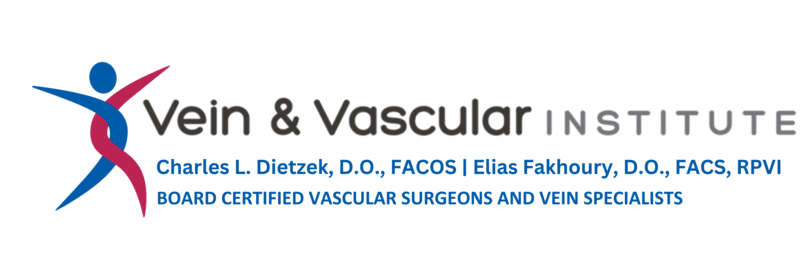Vein Symptom Guide

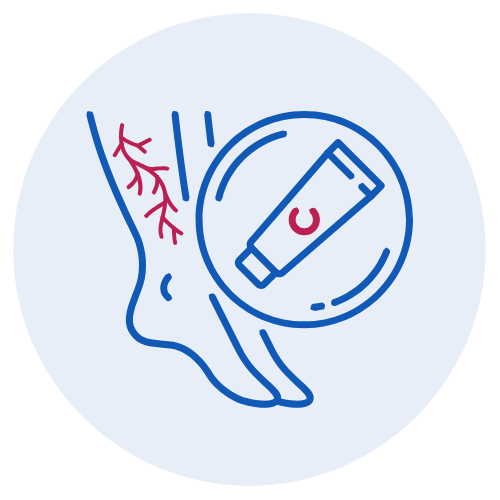
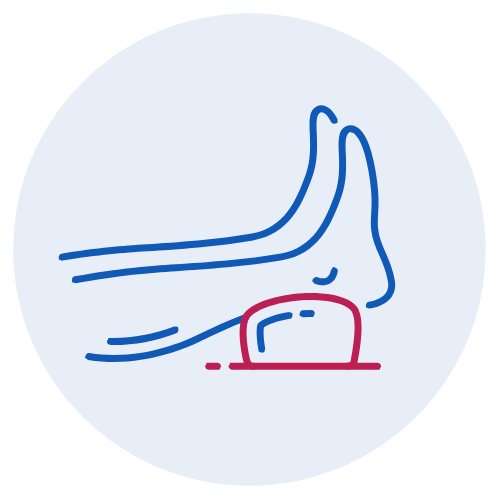
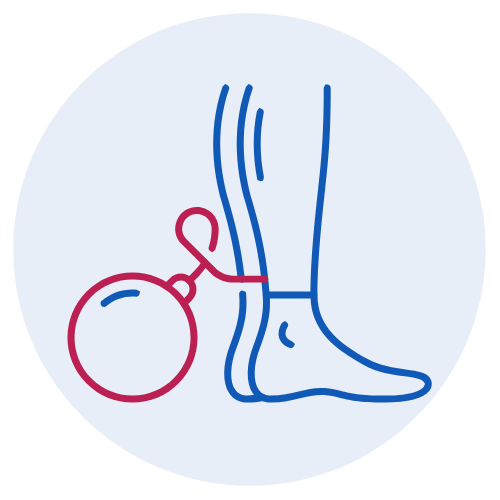
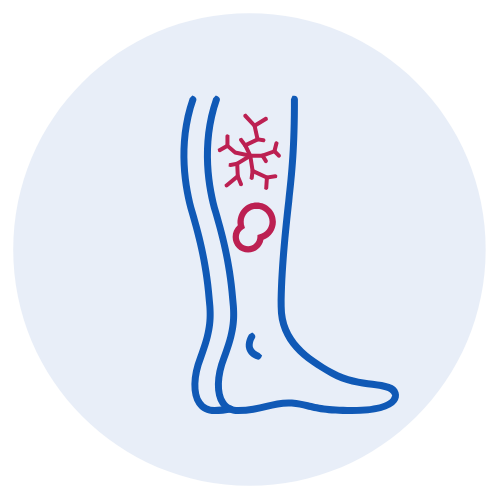

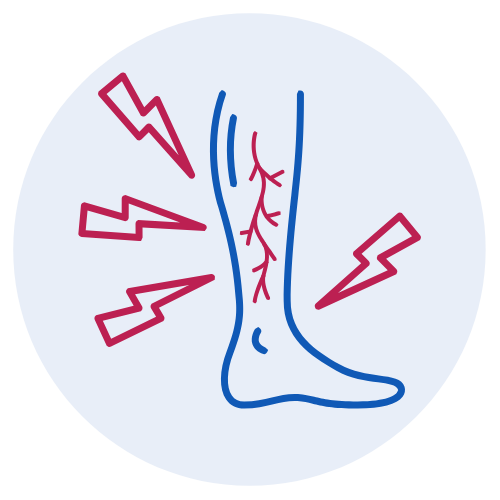
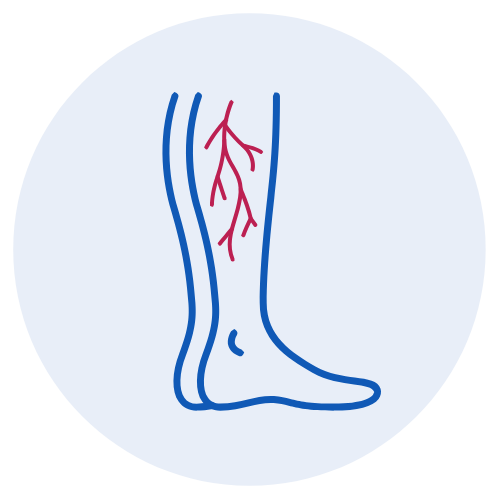
Chronic venous insufficiency (CVI) is a condition that affects over 30 million people in the United States. CVI is the underlying cause of varicose veins. It is twice as common as coronary artery disease (CAD) and five times more prevalent than peripheral artery disease (PAD).
At Vein and Vascular Institute, our mission goes beyond symptom relief—we are committed to treating each patient with personalized, compassionate care. We proudly lead the region in advanced vein treatments and were the first in South Jersey to offer comprehensive care for all forms of vein disease.
Is your vein specialist a board-certified vascular surgeon?
Leg Pain / Aching / Cramping
If you’re experiencing leg pain, aching, or cramping—especially in the calves or thighs—it may be more than just fatigue or overuse. These symptoms are common signs of chronic venous insufficiency (CVI), a condition where the veins in your legs struggle to return blood to the heart effectively. When vein valves become weak or damaged, blood can pool in the legs, leading to increased pressure and poor circulation. This can cause muscles to cramp, legs to feel heavy or achy, and discomfort worsens with prolonged standing or at night. Early diagnosis and treatment can relieve symptoms and prevent more serious complications like skin changes, ulcers, or blood clots.
- Varicose Veins: Enlarged, twisted veins caused by faulty valves.
- Chronic Venous Insufficiency (CVI): Inadequate blood flow due to weakened or damaged vein walls and valves.
- Deep Vein Thrombosis (DVT): Blood clots in deep veins that can lead to serious complications.
- Spider Veins: Smaller, superficial veins that may contribute to discomfort.
A thorough evaluation is critical to understanding the root cause of your symptoms. Our diagnostic process includes:
- Initial Consultation
Discussing your medical history and symptoms in detail. - Physical Assessment
Identifying visible signs like varicose or spider veins. - Ultrasound Imaging
Non-invasive ultrasound to assess blood flow and locate problem areas. - Personalized Treatment Plan
Tailored recommendations based on your specific diagnosis.
We offer minimally invasive solutions to relieve symptoms and improve circulation:
- ClosureFast™
Radiofrequency energy seals damaged veins quickly and safely. - Sclerotherapy
Injected solution collapses small varicose and spider veins. - Ultrasound-Guided Sclerotherapy
Enhanced precision for deeper, non-visible veins. - Microphlebectomy
Removes larger veins through tiny incisions—no stitches needed. - ClariVein®
Combines mechanical and chemical action—no heat or anesthesia required. - VenaSeal™
Medical adhesive closes veins without heat, needles, or compression stockings. - Varithena® Foam
Foam injection targets twisted or large varicose veins. - Endovenous Laser Therapy (EVLT)
Laser fiber closes diseased veins with rapid recovery. - VeinGogh
Treats facial or fine spider veins using targeted radiofrequency.
Common Causes
- Varicose Veins: Enlarged, twisted veins caused by faulty valves.
- Chronic Venous Insufficiency (CVI): Inadequate blood flow due to weakened or damaged vein walls and valves.
- Deep Vein Thrombosis (DVT): Blood clots in deep veins that can lead to serious complications.
- Spider Veins: Smaller, superficial veins that may contribute to discomfort.
How We Diagnose
A thorough evaluation is critical to understanding the root cause of your symptoms. Our diagnostic process includes:
- Initial Consultation
Discussing your medical history and symptoms in detail. - Physical Assessment
Identifying visible signs like varicose or spider veins. - Ultrasound Imaging
Non-invasive ultrasound to assess blood flow and locate problem areas. - Personalized Treatment Plan
Tailored recommendations based on your specific diagnosis.
Advanced Treatment Options
- ClosureFast™ Radiofrequency energy seals damaged veins quickly and safely.
- Sclerotherapy Injected solution collapses small varicose and spider veins.
- Ultrasound-Guided Sclerotherapy Enhanced precision for deeper, non-visible veins.
- Microphlebectomy Removes larger veins through tiny incisions—no stitches needed.
- ClariVein® Combines mechanical and chemical action—no heat or anesthesia required.
- VenaSeal™ Medical adhesive closes veins without heat, needles, or compression stockings.
- Varithena® Foam Foam injection targets twisted or large varicose veins.
- Endovenous Laser Therapy (EVLT) Laser fiber closes diseased veins with rapid recovery.
- VeinGogh Treats facial or fine spider veins using targeted radiofrequency.

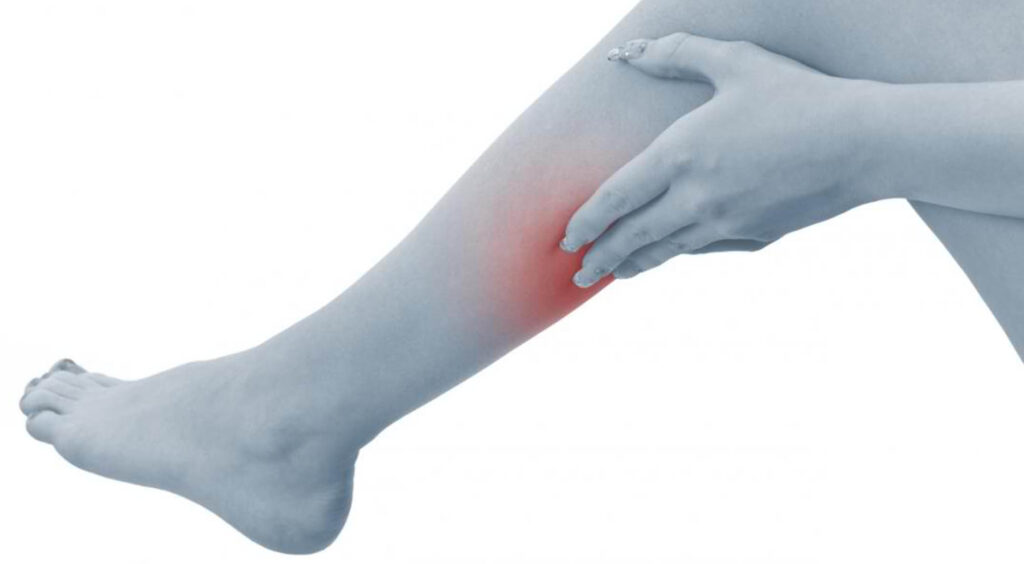
Skin Changes / Discoloration
- Hyperpigmentation: Darkening of the skin, often appearing brown or reddish, typically around the ankles or lower legs.
- Lipodermatosclerosis: Hardened or thickened skin due to chronic inflammation and scarring.
- Venous Stasis Dermatitis: Itchy, red, or scaly skin caused by prolonged venous insufficiency.
- Ulcer Formation: Open sores that develop when skin and underlying tissues break down due to chronic venous pressure.
- Atrophie Blanche: White, scar-like patches of skin with small, visible veins around the area.
A comprehensive diagnostic process helps us determine the root cause of your skin changes and discoloration:
- Initial Consultation
Discussing your symptoms, medical history, and lifestyle factors. - Physical Examination
Identifying visible signs of venous disease, such as discoloration, texture changes, or ulcers. - Ultrasound Imaging
Non-invasive ultrasound to assess blood flow and pinpoint vein abnormalities. - Personalized Treatment Plan
Developing a tailored approach to restore healthy circulation and improve skin health.
We use advanced, minimally invasive procedures to restore healthy blood flow and improve skin appearance in patients experiencing discoloration, thickening, or ulceration due to vein disease:
- ClosureFast™ Radiofrequency energy seals refluxing veins, reducing pressure that leads to skin damage.
- Ultrasound-Guided Sclerotherapy Targets diseased veins below the skin surface, helping reverse skin darkening and inflammation.
- ClariVein® A gentle, no-heat technique that closes problem veins, improving circulation and skin quality.
- VenaSeal™ Uses a medical adhesive to close faulty veins and prevent further skin deterioration.
- Varithena® Foam Foam treatment disperses through diseased veins, reducing chronic pressure and skin discoloration.
- Endovenous Laser Therapy (EVLT) Laser energy shuts down malfunctioning veins, improving skin tone and preventing ulcer formation.
Common Causes
- Hyperpigmentation: Darkening of the skin, often appearing brown or reddish, typically around the ankles or lower legs.
- Lipodermatosclerosis: Hardened or thickened skin due to chronic inflammation and scarring.
- Venous Stasis Dermatitis: Itchy, red, or scaly skin caused by prolonged venous insufficiency.
- Ulcer Formation: Open sores that develop when skin and underlying tissues break down due to chronic venous pressure.
- Atrophie Blanche: White, scar-like patches of skin with small, visible veins around the area.
How We Diagnose
A comprehensive diagnostic process helps us determine the root cause of your skin changes and discoloration:
- Initial Consultation
Discussing your symptoms, medical history, and lifestyle factors. - Physical Examination
Identifying visible signs of venous disease, such as discoloration, texture changes, or ulcers. - Ultrasound Imaging
Non-invasive ultrasound to assess blood flow and pinpoint vein abnormalities. - Personalized Treatment Plan
Developing a tailored approach to restore healthy circulation and improve skin health.
Advanced Treatment Options
- ClosureFast™ Radiofrequency energy seals refluxing veins, reducing pressure that leads to skin damage.
- Ultrasound-Guided Sclerotherapy Targets diseased veins below the skin surface, helping reverse skin darkening and inflammation.
- ClariVein® A gentle, no-heat technique that closes problem veins, improving circulation and skin quality.
- VenaSeal™ Uses a medical adhesive to close faulty veins and prevent further skin deterioration.
- Varithena® Foam Foam treatment disperses through diseased veins, reducing chronic pressure and skin discoloration.
- Endovenous Laser Therapy (EVLT) Laser energy shuts down malfunctioning veins, improving skin tone and preventing ulcer formation.
Leg or Ankle Swelling
Swelling in the legs or ankles—especially by the end of the day or after long periods of standing or sitting—can be a sign of chronic venous insufficiency (CVI). This condition occurs when the valves in your leg veins become weakened or damaged, making it harder for blood to flow back to your heart. As a result, blood pools in the lower legs, increasing pressure and causing fluid to leak into surrounding tissues. This leads to visible swelling and a feeling of heaviness. Left untreated, CVI can progress to skin changes, varicose veins, or even ulcers. If you’re experiencing persistent swelling, it’s important to have your veins evaluated to prevent further complications and improve your comfort.
- Venous Insufficiency: When vein valves don’t function properly, blood pools in the lower legs, causing swelling.
- Lymphedema: Damage to the lymphatic system leads to fluid accumulation.
- Varicose Veins: Enlarged, twisted veins disrupt normal blood flow, contributing to fluid retention.
- Prolonged Standing or Sitting: These activities can worsen swelling by restricting proper circulation.
- Deep Vein Thrombosis (DVT): A blood clot in a deep vein can obstruct blood flow, resulting in swelling.
A comprehensive evaluation helps us identify the root cause of your swelling and create an effective treatment plan.
- Initial Consultation
Discussion of symptoms, medical history, and lifestyle factors. - Physical Assessment
Examination of the legs for signs of swelling, discoloration, or vein issues. - Ultrasound Imaging
Non-invasive ultrasound to evaluate blood flow and identify vein abnormalities. - Customized Treatment Plan
A tailored approach based on your specific diagnosis and needs.
We offer minimally invasive vein treatments that reduce fluid buildup and improve circulation in the legs:
- ClosureFast™ Seals damaged veins with radiofrequency energy to restore proper blood flow and reduce swelling.
- Ultrasound-Guided Sclerotherapy Targets refluxing veins deep under the skin to help alleviate chronic fluid retention.
- ClariVein® Mechanochemical ablation helps treat venous reflux with minimal discomfort or downtime.
- VenaSeal™ Closes faulty veins with a medical adhesive to prevent pooling and reduce ankle swelling.
- Varithena® Foam Foam-based therapy treats large varicose veins that contribute to fluid accumulation.
- Endovenous Laser Therapy (EVLT) Laser treatment eliminates problematic veins, improving blood flow and reducing edema.
Common Causes
- Venous Insufficiency: When vein valves don’t function properly, blood pools in the lower legs, causing swelling.
- Lymphedema: Damage to the lymphatic system leads to fluid accumulation.
- Varicose Veins: Enlarged, twisted veins disrupt normal blood flow, contributing to fluid retention.
- Prolonged Standing or Sitting: These activities can worsen swelling by restricting proper circulation.
- Deep Vein Thrombosis (DVT): A blood clot in a deep vein can obstruct blood flow, resulting in swelling.
How We Diagnose
A comprehensive evaluation helps us identify the root cause of your swelling and create an effective treatment plan.
- Initial Consultation
Discussion of symptoms, medical history, and lifestyle factors. - Physical Assessment
Examination of the legs for signs of swelling, discoloration, or vein issues. - Ultrasound Imaging
Non-invasive ultrasound to evaluate blood flow and identify vein abnormalities. - Customized Treatment Plan
A tailored approach based on your specific diagnosis and needs.
Advanced Treatment Options
- ClosureFast™ Seals damaged veins with radiofrequency energy to restore proper blood flow and reduce swelling.
- Ultrasound-Guided Sclerotherapy Targets refluxing veins deep under the skin to help alleviate chronic fluid retention.
- ClariVein® Mechanochemical ablation helps treat venous reflux with minimal discomfort or downtime.
- VenaSeal™ Closes faulty veins with a medical adhesive to prevent pooling and reduce ankle swelling.
- Varithena® Foam Foam-based therapy treats large varicose veins that contribute to fluid accumulation.
- Endovenous Laser Therapy (EVLT) Laser treatment eliminates problematic veins, improving blood flow and reducing edema.
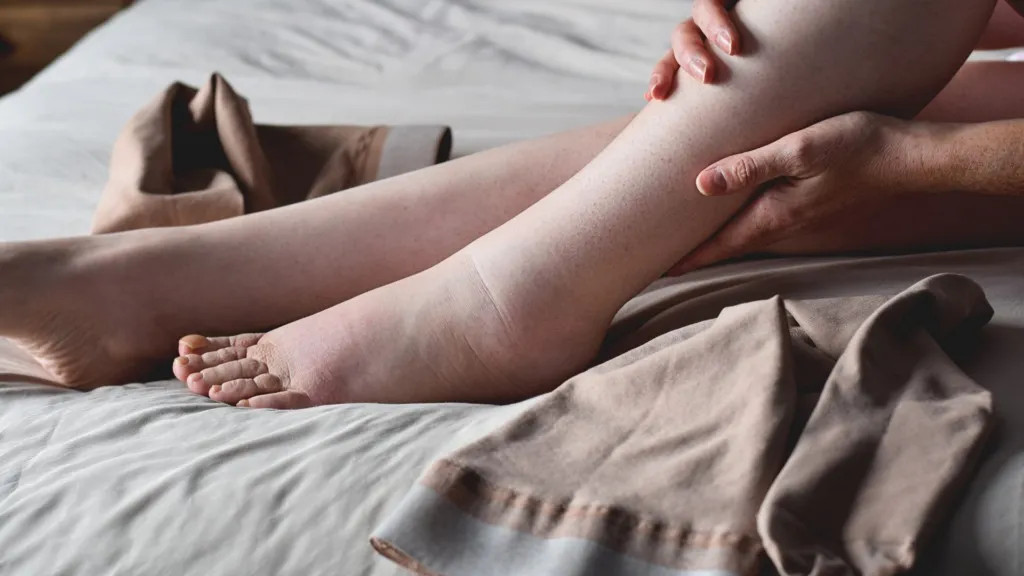
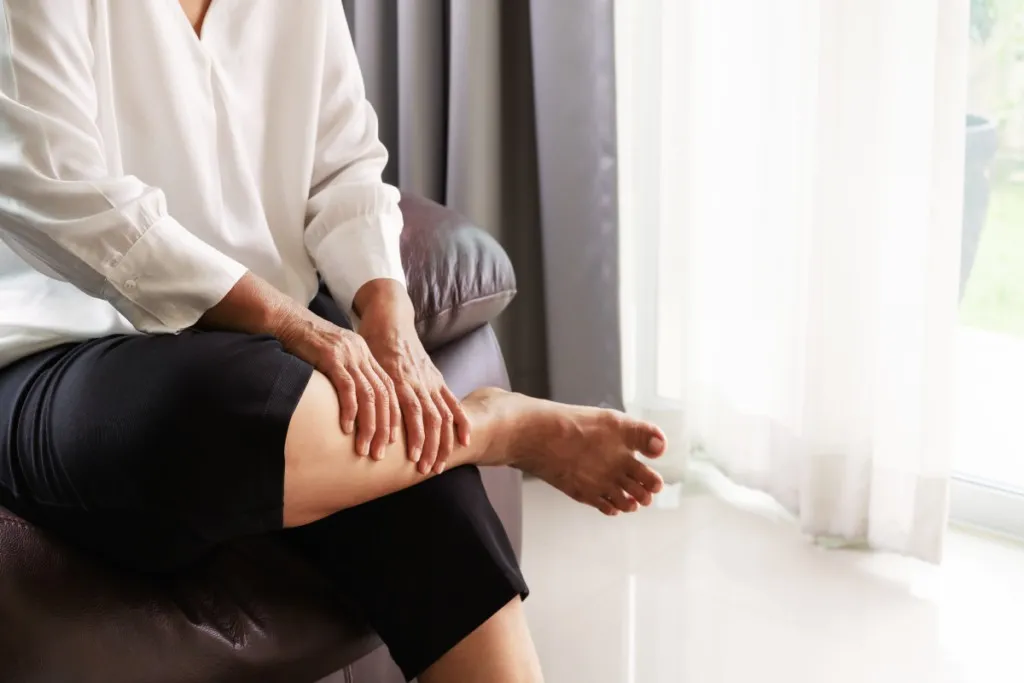
Leg Heaviness & Fatigue
- Venous Insufficiency: Weakened vein valves disrupt blood flow, causing pooling and heaviness.
- Varicose Veins: Enlarged veins create increased pressure and fatigue in the legs.
- Poor Circulation: Reduced blood flow leads to insufficient oxygen and nutrients in the leg muscles.
- Prolonged Activity or Inactivity: Standing or sitting for extended periods exacerbates these symptoms.
Our thorough diagnostic process ensures we identify the root cause of your symptoms and recommend the best course of action:
- Initial Consultation
Discussion of your symptoms, medical history, and lifestyle factors. - Physical Assessment
Examination for visible signs of vein disease, such as varicose veins or swelling. - Ultrasound Imaging
Non-invasive ultrasound to assess blood flow and locate problematic veins. - Personalized Treatment Plan
A tailored approach to address your specific condition and goals.
We provide minimally invasive treatments that relieve leg heaviness and fatigue by improving venous circulation and reducing pressure in the lower legs:
- ClosureFast™ Radiofrequency ablation that closes malfunctioning veins and restores healthy blood flow.
- Sclerotherapy Collapses smaller varicose veins to alleviate fatigue and improve circulation.
- Ultrasound-Guided Sclerotherapy Targets deeper veins contributing to blood pooling and heaviness.
- ClariVein® A no-heat solution for treating refluxing veins that may cause leg fatigue and pressure.
- VenaSeal™ Medical-grade adhesive seals problem veins with no thermal energy or multiple needle sticks.
- Varithena® Foam Foam-based treatment for bulging or tortuous veins linked to discomfort and fatigue.
- Endovenous Laser Therapy (EVLT) Laser treatment that closes problematic veins to reduce pressure and improve energy in the legs.
Common Causes
- Venous Insufficiency: Weakened vein valves disrupt blood flow, causing pooling and heaviness.
- Varicose Veins: Enlarged veins create increased pressure and fatigue in the legs.
- Poor Circulation: Reduced blood flow leads to insufficient oxygen and nutrients in the leg muscles.
- Prolonged Activity or Inactivity: Standing or sitting for extended periods exacerbates these symptoms.
How We Diagnose
Our thorough diagnostic process ensures we identify the root cause of your symptoms and recommend the best course of action:
- Initial Consultation
Discussion of your symptoms, medical history, and lifestyle factors. - Physical Assessment
Examination for visible signs of vein disease, such as varicose veins or swelling. - Ultrasound Imaging
Non-invasive ultrasound to assess blood flow and locate problematic veins. - Personalized Treatment Plan
A tailored approach to address your specific condition and goals.
Advanced Treatment Options
- ClosureFast™ Radiofrequency ablation that closes malfunctioning veins and restores healthy blood flow.
- Sclerotherapy Collapses smaller varicose veins to alleviate fatigue and improve circulation.
- Ultrasound-Guided Sclerotherapy Targets deeper veins contributing to blood pooling and heaviness.
- ClariVein® A no-heat solution for treating refluxing veins that may cause leg fatigue and pressure.
- VenaSeal™ Medical-grade adhesive seals problem veins with no thermal energy or multiple needle sticks.
- Varithena® Foam Foam-based treatment for bulging or tortuous veins linked to discomfort and fatigue.
- Endovenous Laser Therapy (EVLT) Laser treatment that closes problematic veins to reduce pressure and improve energy in the legs.
Ulcers / Sores / Open Wounds
- Chronic Venous Insufficiency (CVI): Faulty vein valves result in poor blood flow, increasing pressure and skin damage.
- Varicose Veins: Enlarged veins disrupt circulation, contributing to tissue breakdown over time.
- Venous Hypertension: Increased pressure in the veins causes inflammation and impaired healing.
- Previous Injuries or Surgeries: Trauma can exacerbate venous issues, delaying wound healing.
Our diagnostic approach focuses on identifying the underlying cause of the wound to ensure effective treatment and faster healing:
- Initial Consultation
Discussing your symptoms, medical history, and wound progression. - Physical Examination
Inspecting the wound and surrounding area for signs of infection, swelling, or discoloration. - Ultrasound Imaging
Using ultrasound to assess blood flow, locate venous obstructions, and evaluate vein function. - Customized Treatment Plan
Developing a tailored strategy to promote wound healing and address the root cause.
Our advanced vein treatments reduce venous pressure and restore circulation, which is essential for healing and preventing leg ulcers and open wounds:
- ClosureFast™
Radiofrequency ablation that closes refluxing veins to improve blood flow and promote skin healing. - Ultrasound-Guided Sclerotherapy
Targets diseased veins contributing to skin breakdown and poor wound healing. - ClariVein®
Non-thermal, minimally invasive treatment to close damaged veins and reduce venous hypertension. - VenaSeal™
Closes abnormal veins using medical adhesive—no heat or multiple injections needed. - Varithena® Foam
Foam therapy reaches twisted or difficult-to-treat veins to relieve pressure and support healing. - Endovenous Laser Therapy (EVLT)
Laser ablation seals off problematic veins to reduce pressure and inflammation near wound sites.
Common Causes
- Chronic Venous Insufficiency (CVI): Faulty vein valves result in poor blood flow, increasing pressure and skin damage.
- Varicose Veins: Enlarged veins disrupt circulation, contributing to tissue breakdown over time.
- Venous Hypertension: Increased pressure in the veins causes inflammation and impaired healing.
- Previous Injuries or Surgeries: Trauma can exacerbate venous issues, delaying wound healing.
How We Diagnose
Our diagnostic approach focuses on identifying the underlying cause of the wound to ensure effective treatment and faster healing:
- Initial Consultation
Discussing your symptoms, medical history, and wound progression. - Physical Examination
Inspecting the wound and surrounding area for signs of infection, swelling, or discoloration. - Ultrasound Imaging
Using ultrasound to assess blood flow, locate venous obstructions, and evaluate vein function. - Customized Treatment Plan
Developing a tailored strategy to promote wound healing and address the root cause.
Advanced Treatment Options
- ClosureFast™ Radiofrequency ablation that closes refluxing veins to improve blood flow and promote skin healing.
- Ultrasound-Guided Sclerotherapy Targets diseased veins contributing to skin breakdown and poor wound healing.
- ClariVein® Non-thermal, minimally invasive treatment to close damaged veins and reduce venous hypertension.
- VenaSeal™ Closes abnormal veins using medical adhesive—no heat or multiple injections needed.
- Varithena® Foam Foam therapy reaches twisted or difficult-to-treat veins to relieve pressure and support healing.
- Endovenous Laser Therapy (EVLT) Laser ablation seals off problematic veins to reduce pressure and inflammation near wound sites.
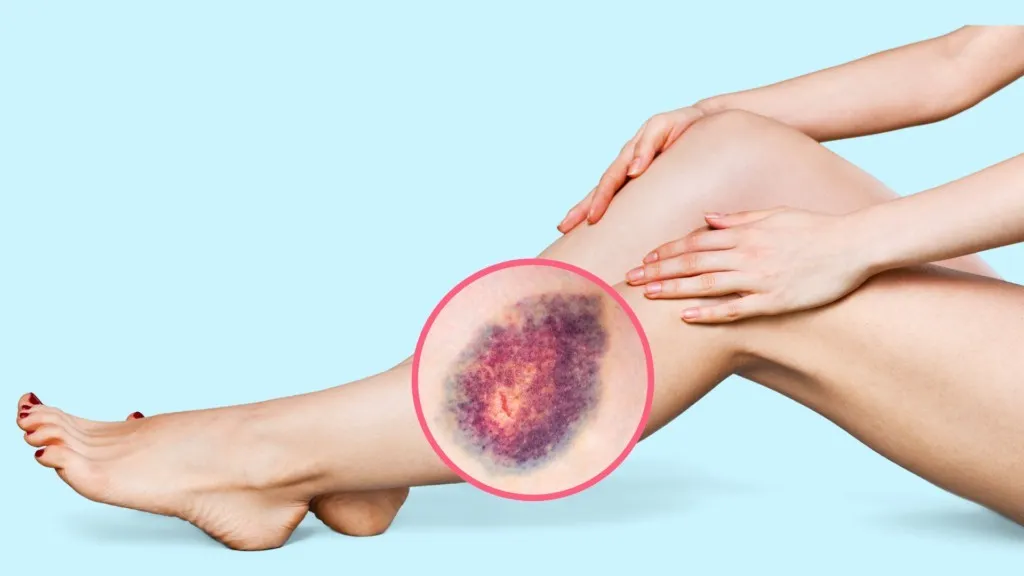
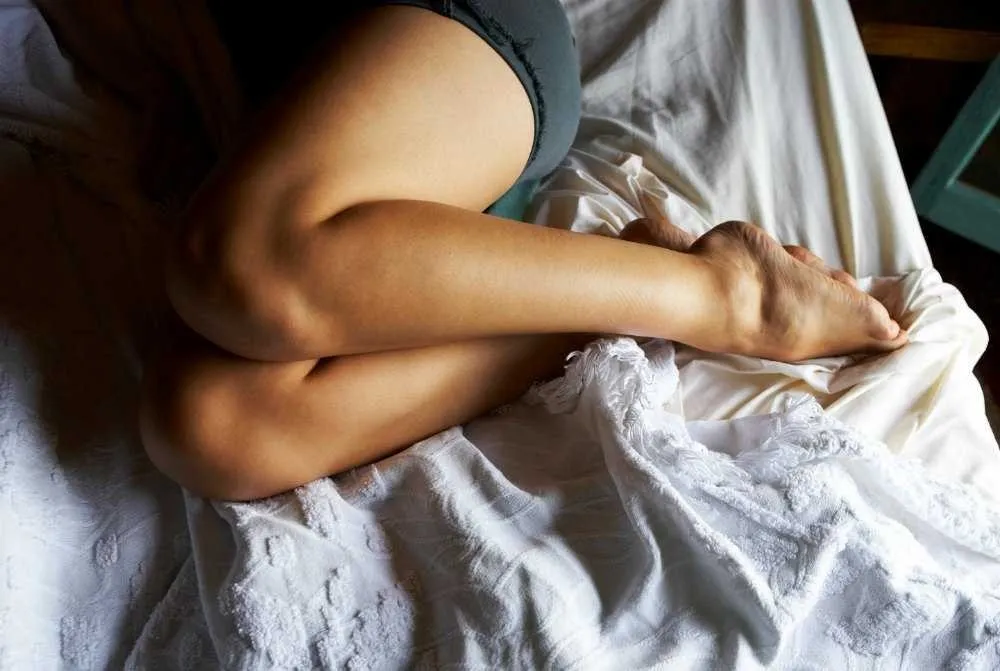
Restlessness in the Legs
- Chronic Venous Insufficiency (CVI): Faulty vein valves cause poor circulation, leading to increased pressure and leg discomfort.
- Varicose Veins: Enlarged veins disrupt blood flow, contributing to the sensations of heaviness and restlessness in the legs.
- Venous Hypertension: High pressure in the veins can trigger symptoms of restless legs, especially during periods of inactivity or rest.
- Nerve Compression or Damage: Poor circulation can aggravate nerve function, leading to restless leg symptoms.
Our diagnostic approach focuses on identifying the underlying circulatory issues contributing to restless legs, allowing us to recommend the most effective treatment plan:
- Initial Consultation
Discussing your symptoms, medical history, and leg discomfort patterns. - Physical Examination
Evaluating the legs for visible signs of vein disease, such as varicose veins or skin changes. - Ultrasound Imaging
Assessing blood flow in the veins, identifying obstructions, and evaluating vein function. - Customized Treatment Plan
Creating a personalized strategy to address both the symptoms and the root cause of restless legs.
We offer minimally invasive vein treatments that improve blood flow, reduce pressure, and alleviate restlessness and discomfort in the legs:
- ClosureFast™ Radiofrequency treatment seals faulty veins to improve circulation and reduce nighttime leg discomfort.
- Sclerotherapy Helps relieve mild circulation issues by collapsing smaller problem veins linked to restlessness.
- Ultrasound-Guided Sclerotherapy Targets deeper, refluxing veins that contribute to uncomfortable leg sensations.
- ClariVein® Combines mechanical agitation with sclerosant delivery to treat underlying venous causes of restlessness.
- VenaSeal™ A non-thermal solution that closes damaged veins and supports healthier leg circulation.
- Varithena® Foam Foam injection treats twisted or enlarged veins contributing to restless leg sensations.
- Endovenous Laser Therapy (EVLT) Eliminates problematic veins using laser energy to relieve pressure and promote leg comfort.
Common Causes
- Chronic Venous Insufficiency (CVI): Faulty vein valves cause poor circulation, leading to increased pressure and leg discomfort.
- Varicose Veins: Enlarged veins disrupt blood flow, contributing to the sensations of heaviness and restlessness in the legs.
- Venous Hypertension: High pressure in the veins can trigger symptoms of restless legs, especially during periods of inactivity or rest.
- Nerve Compression or Damage: Poor circulation can aggravate nerve function, leading to restless leg symptoms.
How We Diagnose
Our diagnostic approach focuses on identifying the underlying circulatory issues contributing to restless legs, allowing us to recommend the most effective treatment plan:
- Initial Consultation
Discussing your symptoms, medical history, and leg discomfort patterns. - Physical Examination
Evaluating the legs for visible signs of vein disease, such as varicose veins or skin changes. - Ultrasound Imaging
Assessing blood flow in the veins, identifying obstructions, and evaluating vein function. - Customized Treatment Plan
Creating a personalized strategy to address both the symptoms and the root cause of restless legs.
Advanced Treatment Options
- ClosureFast™ Radiofrequency treatment seals faulty veins to improve circulation and reduce nighttime leg discomfort.
- Sclerotherapy Helps relieve mild circulation issues by collapsing smaller problem veins linked to restlessness.
- Ultrasound-Guided Sclerotherapy Targets deeper, refluxing veins that contribute to uncomfortable leg sensations.
- ClariVein® Combines mechanical agitation with sclerosant delivery to treat underlying venous causes of restlessness.
- VenaSeal™ A non-thermal solution that closes damaged veins and supports healthier leg circulation.
- Varithena® Foam Foam injection treats twisted or enlarged veins contributing to restless leg sensations.
- Endovenous Laser Therapy (EVLT) Eliminates problematic veins using laser energy to relieve pressure and promote leg comfort.
Tingling or Burning in Leg
- Chronic Venous Insufficiency (CVI): Damaged vein valves hinder proper blood flow, leading to discomfort and skin irritation.
- Varicose Veins: Enlarged veins disrupt circulation, contributing to sensations of burning or tingling in the legs.
- Venous Hypertension: Increased pressure in the veins causes irritation in the skin and nerves, leading to burning sensations.
- Nerve Impairment: Reduced blood flow to the nerves can cause tingling or a “pins-and-needles” feeling.
To effectively address tingling or burning in the leg, we focus on determining the underlying venous issue causing the discomfort:
- Initial Consultation
Discussing your symptoms, medical history, and leg discomfort patterns. - Physical Examination
Inspecting the legs for signs of varicose veins, swelling, or skin changes. - Ultrasound Imaging
Using ultrasound to assess blood flow and identify any blockages or vein dysfunction. - Customized Treatment Plan
Developing a tailored treatment plan to improve circulation and alleviate symptoms.
We offer minimally invasive vein treatments that restore circulation and reduce nerve irritation to relieve tingling or burning sensations in the legs:
- ClosureFast™
Radiofrequency treatment that seals diseased veins, reducing inflammation and nerve-related discomfort. - Ultrasound-Guided Sclerotherapy
Targets deeper problem veins that can contribute to tingling and burning sensations in the legs. - ClariVein®
Non-thermal procedure that improves circulation and relieves skin and nerve irritation. - VenaSeal™
Uses a medical adhesive to close refluxing veins and improve oxygen delivery to the skin and nerves. - Varithena® Foam
Foam injection treats enlarged varicose veins that cause chronic skin discomfort and burning. - Endovenous Laser Therapy (EVLT)
Laser energy closes malfunctioning veins to reduce pressure and restore nerve function.
Common Causes
- Chronic Venous Insufficiency (CVI): Damaged vein valves hinder proper blood flow, leading to discomfort and skin irritation.
- Varicose Veins: Enlarged veins disrupt circulation, contributing to sensations of burning or tingling in the legs.
- Venous Hypertension: Increased pressure in the veins causes irritation in the skin and nerves, leading to burning sensations.
- Nerve Impairment: Reduced blood flow to the nerves can cause tingling or a “pins-and-needles” feeling.
How We Diagnose
To effectively address tingling or burning in the leg, we focus on determining the underlying venous issue causing the discomfort:
- Initial Consultation
Discussing your symptoms, medical history, and leg discomfort patterns. - Physical Examination
Inspecting the legs for signs of varicose veins, swelling, or skin changes. - Ultrasound Imaging
Using ultrasound to assess blood flow and identify any blockages or vein dysfunction. - Customized Treatment Plan
Developing a tailored treatment plan to improve circulation and alleviate symptoms.
Advanced Treatment Options
- ClosureFast™ Radiofrequency treatment that seals diseased veins, reducing inflammation and nerve-related discomfort.
- Ultrasound-Guided Sclerotherapy Targets deeper problem veins that can contribute to tingling and burning sensations in the legs.
- ClariVein® Non-thermal procedure that improves circulation and relieves skin and nerve irritation.
- VenaSeal™ Uses a medical adhesive to close refluxing veins and improve oxygen delivery to the skin and nerves.
- Varithena® Foam Foam injection treats enlarged varicose veins that cause chronic skin discomfort and burning.
- Endovenous Laser Therapy (EVLT) Laser energy closes malfunctioning veins to reduce pressure and restore nerve function.
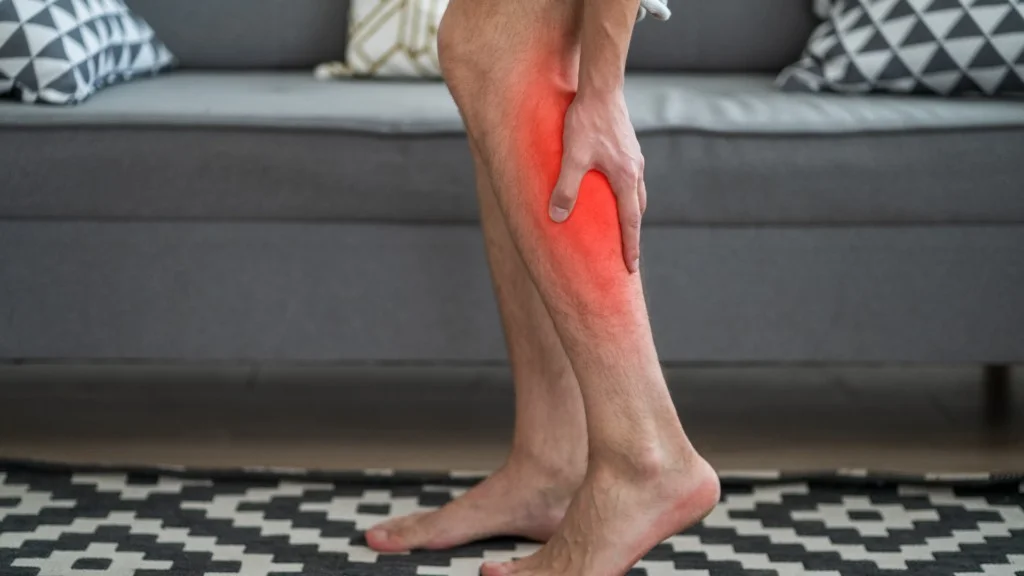

Varicose and Spider Veins
Varicose veins and spider veins are common signs of venous disease, a condition where the veins in your legs struggle to return blood to the heart. Varicose veins are enlarged, twisted veins that often appear blue or purple and may bulge above the skin’s surface. Spider veins, on the other hand, are smaller, red or blue veins that appear closer to the skin and often look like a web or tree branches. While usually painless, they can be a cosmetic concern. While spider veins are usually a cosmetic concern, varicose veins are not and can lead to pain, swelling, and more serious health issues if left untreated.
Fortunately, modern treatments can relieve symptoms and improve appearance with minimal downtime.
- Chronic Venous Insufficiency (CVI): Faulty vein valves allow blood to flow backward, increasing pressure and causing veins to become enlarged.
- Varicose Veins: High blood pressure in leg veins leads to the swelling and twisting of veins.
- Genetics: A family history of vein disease increases the risk of developing varicose and spider veins.
- Hormonal Changes: Pregnancy, menopause, or hormone therapy can weaken vein walls and lead to vein enlargement.
- Prolonged Standing or Sitting: Long periods of inactivity can cause blood to pool in the veins, increasing pressure and contributing to vein enlargement.
- Initial Consultation Discussing your symptoms, family history, and vein concerns.
- Physical Examination Inspecting the veins for signs of swelling, bulging, or discoloration.
- Ultrasound Imaging Assessing the veins to identify any reflux (backward blood flow) and evaluate vein health.
- Customized Treatment Plan Creating a personalized plan to address both the visible veins and the underlying circulation issues.
We offer a full range of treatments for both varicose and spider veins, addressing cosmetic concerns and underlying vein disease:
- ClosureFast™
Minimally invasive radiofrequency procedure that seals large, bulging varicose veins. - Sclerotherapy
Injected solution collapses small varicose and spider veins near the skin’s surface. - Ultrasound-Guided Sclerotherapy
Targets deeper veins not visible on the surface that may be feeding spider veins. - Microphlebectomy
Physically removes large, twisted veins through tiny punctures—ideal for bulging veins. - ClariVein®
A catheter-based treatment combining chemical and mechanical action for symptomatic veins. - VenaSeal™
Adhesive-based closure of refluxing veins without heat or the need for compression stockings. - Varithena® Foam
Foam solution treats twisted or tortuous veins that cause bulging and discomfort. - Endovenous Laser Therapy (EVLT)
Laser-based closure of diseased veins to relieve pressure and improve vein appearance. - VeinGogh
Pinpoint radiofrequency treatment ideal for fine facial or leg spider veins. - Laser Treatment
Non-invasive laser therapy targets tiny spider veins on the face or legs with no needles.
Common Causes
- Chronic Venous Insufficiency (CVI): Faulty vein valves allow blood to flow backward, increasing pressure and causing veins to become enlarged.
- Varicose Veins: High blood pressure in leg veins leads to the swelling and twisting of veins.
- Genetics: A family history of vein disease increases the risk of developing varicose and spider veins.
- Hormonal Changes: Pregnancy, menopause, or hormone therapy can weaken vein walls and lead to vein enlargement.
- Prolonged Standing or Sitting: Long periods of inactivity can cause blood to pool in the veins, increasing pressure and contributing to vein enlargement.
How We Diagnose
Our diagnostic process focuses on identifying the underlying causes of varicose and spider veins, allowing for the most effective treatment:
- Initial Consultation
Discussing your symptoms, family history, and vein concerns. - Physical Examination
Inspecting the veins for signs of swelling, bulging, or discoloration. - Ultrasound Imaging
Assessing the veins to identify any reflux (backward blood flow) and evaluate vein health. - Customized Treatment Plan
Creating a personalized plan to address both the visible veins and the underlying circulation issues.
Advanced Treatment Options
- ClosureFast™ Minimally invasive radiofrequency procedure that seals large, bulging varicose veins.
- Sclerotherapy Injected solution collapses small varicose and spider veins near the skin’s surface.
- Ultrasound-Guided Sclerotherapy Targets deeper veins not visible on the surface that may be feeding spider veins.
- Microphlebectomy Physically removes large, twisted veins through tiny punctures—ideal for bulging veins.
- ClariVein® A catheter-based treatment combining chemical and mechanical action for symptomatic veins.
- VenaSeal™ Adhesive-based closure of refluxing veins without heat or the need for compression stockings.
- Varithena® Foam Foam solution treats twisted or tortuous veins that cause bulging and discomfort.
- Endovenous Laser Therapy (EVLT) Laser-based closure of diseased veins to relieve pressure and improve vein appearance.
- VeinGogh Pinpoint radiofrequency treatment ideal for fine facial or leg spider veins.
- Laser Treatment Non-invasive laser therapy targets tiny spider veins on the face or legs with no needles.
Why Start Vein Treatment Now?
- Untreated vein disease can lead to serious complications like ulcers or blood clots.
- Early treatment not only alleviates discomfort but also prevents further issues.
- Most patients notice a significant improvement within a week!
